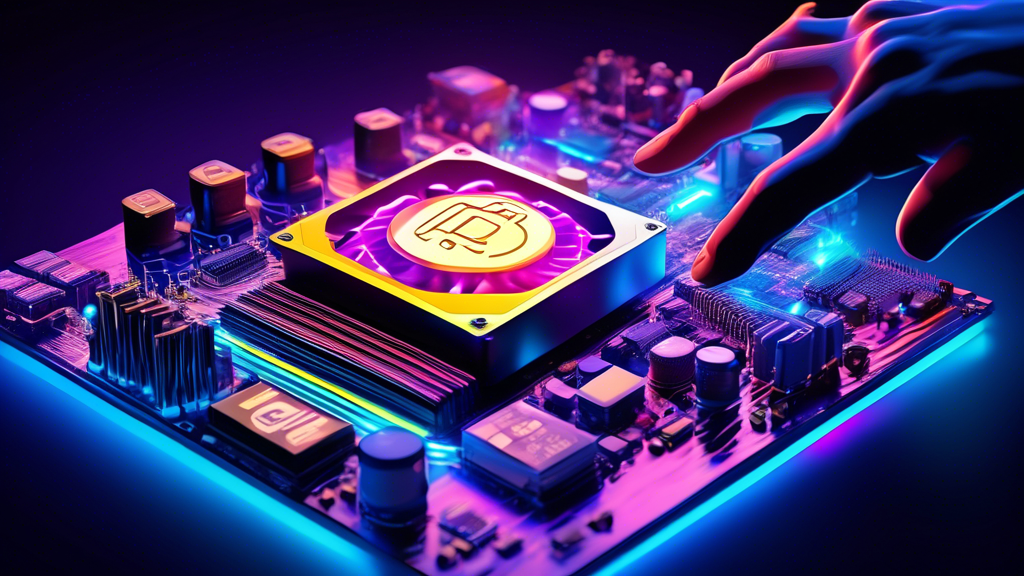Crypto Mining: A Beginner’s Guide
Crypto mining has emerged as a hot topic in the world of cryptocurrency, attracting both seasoned investors and curious beginners. But what exactly is crypto mining, and how can you get started? This comprehensive guide will walk you through the essentials of crypto mining, from understanding the basic concepts to navigating the practical aspects of this complex yet rewarding process.
Understanding Crypto Mining: How Does it Work?
At its core, crypto mining is the process of using computer power to solve complex mathematical problems, thereby validating transactions and adding them to a blockchain. This decentralized process ensures the security and integrity of the cryptocurrency network.
There are two primary mining methods: Proof-of-Work (PoW) and Proof-of-Stake (PoS). PoW, the original method, requires miners to compete to solve cryptographic puzzles, with the winner receiving mining rewards. PoS, a newer approach, selects validators based on the number of coins they hold, making it more energy-efficient. Understanding these methods is crucial for comprehending the dynamics of the crypto space.
To navigate the world of crypto mining, you’ll need to familiarize yourself with key terminology. Hash rate refers to the processing power of your mining hardware. A blockchain is a distributed ledger that records all transactions. Mining pools allow miners to combine their computing power to increase their chances of earning rewards. Finally, mining rewards are the financial incentives miners receive for successfully validating transactions.
Understanding Crypto Mining: How Does it Work?
Crypto mining might seem like a mysterious process, but at its core, it’s a fundamental component of how many cryptocurrencies function. In simple terms, crypto mining is the use of computer processing power to solve complex mathematical problems, thereby validating transactions and securing the blockchain network.
What is Crypto Mining?
Imagine a digital ledger where every cryptocurrency transaction is recorded. This ledger is called the blockchain. To ensure the integrity and security of this ledger, new transactions need to be verified and added to the blockchain in a trustworthy manner. This is where crypto mining comes in.
Miners, using their computing power, compete to solve these complex mathematical problems. The first miner to solve the problem gets to add a new block of transactions to the blockchain and is rewarded with newly minted cryptocurrency tokens. This process also ensures the security of the blockchain by making it extremely difficult for any single entity to manipulate transaction history.
Different Mining Methods: Proof-of-Work (PoW) vs. Proof-of-Stake (PoS)
There are different ways to achieve consensus and validate transactions on a blockchain. Two prominent methods are Proof-of-Work (PoW) and Proof-of-Stake (PoS).
Proof-of-Work (PoW) is the original consensus mechanism used by Bitcoin and many other cryptocurrencies. It relies on miners solving complex mathematical puzzles, requiring significant computational power. This process is energy-intensive but provides a high level of security.
Proof-of-Stake (PoS) is an alternative consensus mechanism that aims to address the energy consumption concerns of PoW. In PoS, instead of miners competing with computing power, validators are chosen based on the number of cryptocurrency tokens they hold and are willing to stake or lock up as collateral. This system is generally more energy-efficient but introduces other complexities and potential vulnerabilities.
Key Terminology in Crypto Mining
To understand crypto mining better, it’s essential to grasp some key terms:
- Hash rate: A measure of your computer’s processing power, specifically its ability to perform the calculations necessary for mining. A higher hash rate generally translates to a better chance of solving the puzzle and earning rewards.
- Blockchain: The digital ledger where all cryptocurrency transactions are recorded in a secure and transparent manner. It’s a decentralized and distributed system, making it resistant to tampering.
- Mining pool: A group of miners who combine their computing power to increase their chances of solving blocks and sharing the rewards. This is particularly beneficial for individual miners with limited resources.
- Mining rewards: The cryptocurrency tokens that miners receive as a reward for successfully validating transactions and adding blocks to the blockchain. These rewards vary depending on the specific cryptocurrency and network conditions.
By understanding these fundamental concepts, you’ll be better equipped to navigate the world of crypto mining and make informed decisions about whether it’s a suitable endeavor for you.

Getting Started with Crypto Mining: Essential Steps
So, you’re intrigued by the world of crypto mining and ready to dive in. That’s great! But before you start generating digital gold, there are a few crucial steps you need to take to set yourself up for success. Let’s break down the essential steps to get started with crypto mining:
Choosing the Right Cryptocurrency
The first step in your crypto mining journey is deciding which cryptocurrency you want to mine. This decision is far from arbitrary, as various factors come into play. Here’s what you should consider:
- Profitability: This is often the primary driver. Research which cryptocurrencies offer the best potential returns based on current market conditions, block rewards, and mining difficulty.
- Mining Difficulty: Mining difficulty reflects the computational effort required to solve a block and earn rewards. Higher difficulty means more competition and potentially less profitability for individual miners.
- Hardware Requirements: Different cryptocurrencies require varying levels of computing power. Ensure your hardware aligns with the chosen cryptocurrency’s demands.
- Future Potential: Consider the long-term prospects of the cryptocurrency. Does it have a strong development team? Is there growing community support? A cryptocurrency with solid fundamentals might be a more promising investment.
Conduct thorough research, explore online resources, and compare different options before committing to a specific cryptocurrency to mine.
Selecting Your Mining Hardware
Now that you’ve chosen your target cryptocurrency, it’s time to select the right tools for the job – your mining hardware. The type of hardware you need depends heavily on the cryptocurrency you’ve chosen. Here are the most common options:
- CPUs (Central Processing Units): CPUs are the brains of your computer and can be used for mining. However, they are generally less efficient than GPUs or ASICs and are typically not suitable for mining most profitable cryptocurrencies.
- GPUs (Graphics Processing Units): GPUs, initially designed for rendering graphics, excel at parallel processing, making them well-suited for crypto mining. They offer a good balance between price and performance.
- ASICs (Application-Specific Integrated Circuits): ASICs are specialized hardware designed solely for mining a particular cryptocurrency. They offer the highest hash rate but are expensive and lack versatility.
When choosing your hardware, consider these factors:
- Hash Rate: The higher the hash rate, the more computational power your hardware has, leading to faster block solving and increased potential earnings.
- Power Consumption: Mining consumes a significant amount of electricity. Factor in the power consumption of your chosen hardware and calculate its impact on your overall profitability.
- Cost: Balance the cost of the hardware with its potential returns. Ensure the investment makes financial sense in the long run.
- Availability: High demand for mining hardware can lead to supply shortages. Research and compare prices from reputable vendors before purchasing.
Setting Up Your Mining Software and Joining a Pool
Once you have your hardware, you need to set up mining software that acts as the interface between your hardware and the cryptocurrency’s blockchain network. Many different mining software options are available, each with its own features and supported cryptocurrencies.
Here’s a simplified breakdown of setting up mining software:
- Choose your software: Popular options include CGMiner, BFGMiner, EasyMiner, and NiceHash. Research and select the software that best suits your needs and supports your chosen cryptocurrency.
- Download and install the software: Download the software from a trusted source and follow the installation instructions provided.
- Configure your mining settings: Input your mining pool information (discussed below), wallet address, and other relevant settings as required by the software.
Joining a Mining Pool: A Collaborative Approach
Mining solo, especially for beginners, can be challenging and often less profitable. Joining a mining pool allows you to combine your computing power with other miners, increasing your chances of solving blocks and earning rewards. Here’s why it’s beneficial:
- Increased Hash Rate: By combining resources, pools have a much higher hash rate, improving the odds of finding blocks.
- Regular Payouts: Pools distribute rewards among participants based on their contributed hash rate, ensuring more frequent and consistent payouts.
- Reduced Variance: Pool mining smooths out the fluctuations in earnings, providing a more predictable income stream.
When choosing a mining pool, consider factors such as its size, reputation, fees, payout structure, and the cryptocurrencies it supports.
By carefully selecting the right cryptocurrency, investing in suitable hardware, and joining a mining pool, you’ll be well on your way to entering the exciting world of crypto mining. Remember to stay informed, adapt to the ever-evolving crypto landscape, and approach mining with a long-term perspective for optimal results.

Crypto Mining: Costs, Risks, and Considerations
Before diving headfirst into the world of crypto mining, it’s crucial to understand the associated costs, risks, and important considerations. While the allure of mining digital gold can be strong, a realistic assessment of the financial and environmental implications is essential for making informed decisions.
Electricity Costs and Profitability Calculations
Crypto mining, especially with energy-intensive hardware like ASICs, demands a significant amount of electricity. The cost of electricity varies greatly depending on your location, directly impacting your mining profitability. Accurately calculating your potential earnings involves factoring in your electricity costs, the hash rate of your mining hardware, and the current mining rewards for your chosen cryptocurrency.
There are numerous online crypto mining profitability calculators available that can help you estimate potential profits based on these factors. However, it’s important to remember that these are just estimates. Cryptocurrency markets are highly volatile, and mining difficulty can fluctuate, impacting your actual earnings.
Environmental Impact of Crypto Mining
One of the most significant concerns surrounding crypto mining is its environmental impact. The massive amounts of electricity consumed by mining operations often come from fossil fuel-based power grids, contributing to carbon emissions and environmental degradation.
However, the industry is taking steps towards sustainable practices. Many mining farms are transitioning towards renewable energy sources like solar, wind, and hydro power. Additionally, some cryptocurrencies utilize alternative consensus mechanisms like Proof-of-Stake (PoS) that require significantly less energy than traditional Proof-of-Work (PoW) systems.
As a responsible miner, consider the environmental impact of your operations. Research and support mining projects committed to sustainability, and explore the use of renewable energy sources whenever possible.
Regulatory Landscape and Security Considerations
The regulatory landscape surrounding crypto mining is constantly evolving. Governments worldwide are grappling with how to classify and regulate cryptocurrencies, and this uncertainty can impact mining operations. Some jurisdictions have imposed restrictions or bans on crypto mining, while others are adopting more favorable regulations.
It’s crucial to stay informed about the legal and regulatory developments in your region to ensure you operate within the bounds of the law. Additionally, familiarize yourself with the tax implications of crypto mining profits, as these can vary significantly depending on your location.
Security is another critical consideration. Crypto mining involves handling digital assets and potentially sensitive information, making it a target for cyberattacks. Ensure you have robust security measures in place, such as strong passwords, two-factor authentication, and up-to-date antivirus software.
Furthermore, be wary of scams and fraudulent schemes targeting crypto miners. Research and verify the legitimacy of any mining pools or services you engage with to avoid falling victim to scams.
Crypto mining can be a complex and challenging endeavor, but by carefully considering the costs, risks, and environmental and regulatory considerations, you can make informed decisions and navigate the world of crypto mining responsibly and successfully.
Crypto Mining: Is It for You?
Crypto mining can be a complex and challenging endeavor, but it can also be rewarding for those who are willing to put in the time and effort. By understanding the fundamentals, carefully weighing the costs and risks, and staying informed about the ever-evolving crypto landscape, you can make more informed decisions about whether crypto mining is the right path for you. As with any investment, proceed with caution, conduct thorough research, and never invest more than you can afford to lose.
Looking Ahead: The Future of Crypto Mining
The world of crypto mining is constantly evolving. New cryptocurrencies emerge, mining technologies advance, and the regulatory landscape shifts. Staying updated on these changes is crucial for miners to adapt and thrive. As the crypto ecosystem matures, it’s exciting to see how mining will continue to play a pivotal role in shaping the future of this revolutionary technology.
